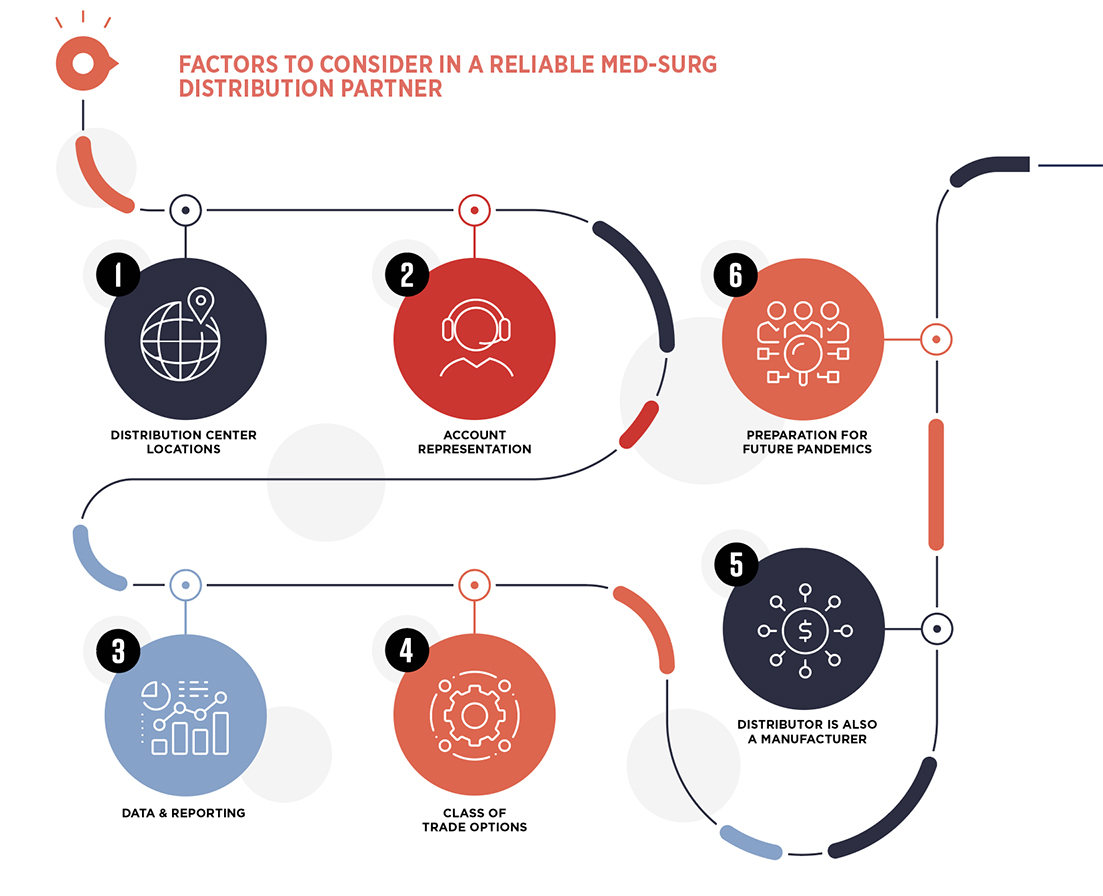A solid distribution partner is critical to the health of your supply chain

Having a reputable and trusted distribution partnership has been at the forefront of healthcare supply chain since the onset of the COVID-19 pandemic. “Over the course of the last three years, providers have been met with everyday challenges relating to product shortages, back orders, allocations and shipments being continually delayed,” says Mark Nixon, Senior Director of Strategic Sourcing and Distribution for HealthTrust. “When choosing a distributor, providers need assurance that a solid relationship is in place to provide continued patient care.”
Distributors are multifaceted and can offer an array of products and services to meet the needs of their healthcare customers—whether they are a large IDN with many locations or a single, small facility.
“Especially after going through the disruption and shortages brought on by the pandemic, it’s important that members understand what HealthTrust looks for in distributor partners to help mitigate the risks of future disruptions,” explains Nixon. “HealthTrust seeks to find distribution relationships where the distributor has a broad understanding of the med-surg market and has established relationships with contracted suppliers. We contract with distributors who are capable of correctly maintaining supply chain pipelines in order to manage and maintain product stock levels required by the membership.” As another supply safeguard, Nixon shares that if a supplier offers products through distribution, HealthTrust aims to have all contracted med-surg distributors offer the same exact products.
 When reviewing and selecting a reliable and trustworthy med-surg distribution partner, Nixon suggests keeping in mind the following considerations:
When reviewing and selecting a reliable and trustworthy med-surg distribution partner, Nixon suggests keeping in mind the following considerations:
1. Distribution Center Locations
National distributors have a broad footprint of locations across the United States and globally. To reduce the risk of delivery delays, providers should look for a distributor within a comfortable distance of their facilities. Having a conveniently located distribution center can help minimize transportation costs and, in return, may lower a provider’s markup* on distributed products. Having a distributor who is in close proximity to a provider is useful when particular products are urgently needed. Additionally, in the event of inclement weather or a natural disaster, distributors may not be able to ship products from a specified location. Having a distributor that has multiple sites within a geographic area can help minimize delays. (*The provider has a fixed markup that is charged by the distributor.)
2. Account Representation
An account representative (“rep”) is the single point of contact designated to manage a relationship and help meet a provider’s objectives. The representative should routinely analyze sales data, enabling them to make recommendations for standardization and to provide accurate statistics related to purchasing behavior. Pricing management, forecasting product use and monitoring distributor performance are a representative’s essential responsibilities. The rep should be the provider’s first point of contact for customer service issues or impactful disruptions. It is critical for the representative to maintain a healthy relationship between the provider and distributor to build trust between both organizations.
3. Data & Reporting
Having a distributor that can provide reporting through analytics tools and dashboards allows for better transparency of data. While reporting purchase order placement and costs is important, distributors should offer data around delivery dates, fill rates, price accuracy and the fulfillment of complete orders. The distributor should also offer insight into product alternatives or substitutions for those that are either not available or on backorder. Data can also offer opportunities for SKU rationalization that can lead to product consolidation and standardization. Lastly, reporting around quality issues or metrics should be available with details containing damaged or defective products, errors in orders or pricing and the failure to meet any established delivery timeframes.
4. Class of Trade Options
Distribution shouldn’t be a one-size-fits-all model. The shift in care has seen providers grow beyond traditional acute care facilities and surgery centers to expanded options and broader locations such as physician clinics, long-term acute care hospitals, home health, hospice, rehabilitation, urgent care and wound care centers. Distributors should tailor to a provider’s needs through the requirements of their specific locations. Examples of requirements may include smaller order placement through bulk breaks or minimal delivery dates.
5. Distributor Is Also a Manufacturer
Many distributors manufacture their own products contracted under HealthTrust across a variety of healthcare categories. Having a distributor that is contracted with HealthTrust, that sells its own brand of products, is beneficial to accessibility and the reliable delivery of those commodities. The distributor shouldn’t assess a markup on its own brand of products that are purchased by a provider. This scenario allows for cost savings on those purchases.
6. Preparation for Future Pandemics
Distributors should have contingency plans in place should any future pandemic break out. This would include a larger selection of vetted manufacturers that are able to supply PPE (personal protective equipment). Providers need assurance that allocation procedures are available that would allow for the conservation of products. Distributors should provide literature detailing an overview of PPE-related products as well as product specifications approved by various healthcare governing bodies such as NIOSH, FDA, CDC and OSHA. HealthTrust’s national agreements detail supplier performance warranties, fill rate requirements and business continuity planning clauses.
Distribution is much more than creating a purchase order and having products delivered to a facility. “As providers continue to navigate the post-pandemic environment, the health of the supply chain is contingent on effective risk mitigation,” says Nixon. “Aligning with a distributor who is a strategic partner has become the new normal.”
A strategic distribution partner is one who has evolved the relationship into a consultative role—everything from helping to manage product availability and suggesting changes by interpreting data to executing deliverables that enable the clinicians who deliver patient care to have quality products and services when and where they need them.
For more information on distributors available to your healthcare facility, review the Commitment Agreements within the contract launch packages. Contact your HealthTrust Account Manager, or email thesource@healthtrustpg.com for assistance.
Share Email Distribution, Q3 2023




